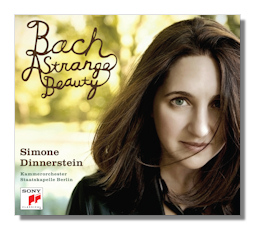
The Internet's Premier Classical Music Source
Related Links
- J.S. Bach Reviews
- Latest Reviews
- More Reviews
-
By Composer
-
Collections
DVD & Blu-ray
Books
Concert Reviews
Articles/Interviews
Software
Audio
Search Amazon
Recommended Links
Site News
 CD Review
CD Review
Johann Sebastian Bach

A Strange Beauty
- Keyboard Concerto #1 in D minor, BWV 1052
- Keyboard Concerto #5 in F minor, BWV 1056
- English Suite #3 in G minor, BWV 808
- Ich ruf zu Dir, Jesu Christ, BWV 639, arr. Busoni
- Nun freut euch, lieben Christen gemein, BWV 734, arr. Kempf
- Jesu, Joy of Man's Desiring, BWV 147, arr. Hess
Simone Dinnerstein, piano
Kammerorchester Staatskapelle Berlin/Simone Dinnerstein
Sony Classical 88697-81742-2 2011 62:07
Let it be noted, first of all, that none of this music is played as Bach wrote it, most obviously because the piano did not exist in his day. He wrote the keyboard concertos for harpsichord after first writing surely one, and probably both, as violin concertos; he later used music from both in cantatas. Two of the short works later arranged by modern musicians began their existence as parts of cantatas and the third as a chorale. Moreover, Dinnerstein's interpretations of these pieces depart considerably from the usual practice of other musicians who have played these pieces on the piano.
In fact, Dinnerstein, in the interview in the brochure accompanying the disc, and on a NPR interview at the time of the release of this recording, actually flaunts her disregard of standard practice. In particular she rejects the very idea of an unrelenting pulse. She proposes to interpret Bach for the 21st Century. She justifies her choices, first by noting that Bach himself deviates from his own patterns, symmetry and logic. "He changes a sequence slightly or alters the rhythmic stress in a measure so that suddenly you don't know where the downbeat is." Bach's "syncopation and displacement of the downbeat" tells Dinnerstein that "Bach wasn't being driven by downbeats and bar lines." And "everything about the way he writes is mysterious and unexpected," hence her title for this release, inspired by a remark about beauty by Francis Bacon.
Accordingly, Dinnerstein plays "very freely" and is expressive, rather than focusing on structure and form. The concertos are played like chamber music, with the string players following the lead of the pianist, but with her listening to them also, she says. Certainly, there is no tension between soloist and orchestra. Her performances will not be to every taste, of course, and are bound to arouse some controversy.
So how does the music sound, played this way? Generally fresh, never dull, sometimes surprising. Often beautiful, notably in the slow movements of the concertos, and the fast playing is sprightly. Some rhythms are strong enough to dance to. Dynamic contrast between different voices in the counterpoint brings out the lines. Dinnerstein, a student of Peter Serkin and a Juilliard graduate, is a highly skilled player and what she does is all purpose-driven. She has performed widely on three continents and has won awards. Her recording of Bach's Goldberg Variations was highly praised and sold spectacularly from the week of its release. If what she avowedly sets out to do does not completely put you off, you may find this release of great interest. You may love it.
Copyright © 2011, R. James Tobin





















